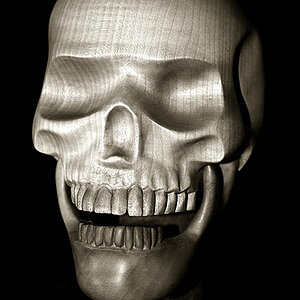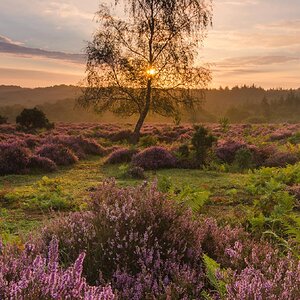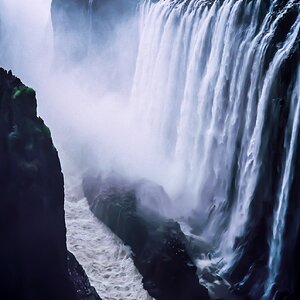By terri at Tue, 2006-11-07 20:49
Welcome to the fourth installment of Jim Hannah's Black & White Film Photography! Enjoy the series!
Black and White Film Photography - a Primer
by Jim Hannah
Part IV: Contact printing
Introduction.
One of the advantages of developing your own B&W film is that you can examine the results and decide on which negatives you wish to print. It's the film-user's answer to the 'delete' function on a digital camera. But there's a problem here, isn't there? How do you learn to 'read' a negative to make the decision?
The answer: make a contact print of each negative. Contact prints are positives. While they're small (the same size as the negative), they're 'normal' - that is, the shades of light to dark are those of the original scene and not the reverse image of a negative. Any simple household magnifier then allows you to examine the contact images in detail.
Contact prints can also serve as a filing system. You can fit an entire 36 exposure roll of 35mm film or all 12 or 16 exposures of a roll of 120 film on a single sheet of 8" x 10" enlarging paper. When we discussed film developing, we suggested cutting 35mm rolls into strips of 6 frames each and 120 film into strips of 3 frames each [6cm x 6cm] or 4 frames each [4.5cm x 6cm]. This was to ensure that the negatives from a roll would fit on one sheet of paper. Once you have a darkroom set up and ready to go, a contact print can be made, start to finish, in about 15 minutes.
We'll describe a single procedure here just as we did for film development. And as with film development, once you have a successful procedure up and running, feel free to explore any of the many other developers and fixers available.
There are six steps to the process: exposure, development, stop bath, fixing, washing and drying. Only one developer and fixer will be covered in this article.
The darkroom.
Contact printing and enlarging require an absolutely dark room lit only by a safelight. This doesn't mean that you have to set a room aside just for photography. That luxury may not be practical. All you really need is a room that can be converted into a temporary darkroom. The room must be light-proofed and arrangements have to be made for a safelight, three developing trays, an enlarger or contact print light and some flat workspace. A little setting-up and Presto! -- an almost-instant darkroom. A roomy bathroom with a tub is just about ideal. A sheet of plywood can be placed across the tub to make a work surface. Bathrooms usually have one window and one door. That makes them easy to light-proof, especially at night. A curtain made up of four layers of black plastic trash bag sheet will block out all light. A corner of a basement can also serve as a temporary darkroom.
Once a print has been processed through the fixer step, the lights can be turned on again. The print can be taken to another room such as the kitchen for final washing and drying.
Paper development chemistry.
Paper development is somewhat different from film development. In developing film, we used a very slow-acting developer so that we could accurately time the process and arrest it with a stop bath when the image on the film was just starting to darken in the darkest shadow areas but had not gone fully black in the lightest highlight areas. By doing this, we captured detail at both extremes.
In paper development, we'll use a strong, fast developer and allow the image on the paper to develop fully. As with film, the sensitized silver salt is changed into pure silver. A stop bath is still used, but its function is reduced to keeping the developer from reacting with the fixer and weakening it. The fixer reacts with any remaining silver salt. Washing removes the fixer and any other soluble by-products.
In film development, it's important to keep the concentration of the developer constant from roll to roll. We did that by using a developer once and discarding it. The developer for paper is so strong that we don't have to worry about concentration until it is almost all used up. We'll track this by counting the number of sheets of paper we process in it.
Equipment and materials.
Here's what you need to make contact prints.
Enlarging paper
A good paper to start with is the Ilford variable contrast [VC] resin-coated [RC] 8" x 10" paper. It comes in packages of 25 sheets. Resin-coated papers wash quickly and are easy to handle. Any surface will do, but some people prefer the glossy surface for contact prints. There are many other VC RC papers available. All of them will work for contact prints. Single contrast #2 paper will also make good contact prints.
Enlarger or a dim light source.
If you have an enlarger, you can use it as the light source for contact prints. If you don't have one, you can use an ordinary 4 watt night light. Don't try to use a flashlight, though. It's tempting, but the light is too uneven for consistent results.
Thermometer.
Use the thermometer described in the film development article.
Clock or timer.
The exposure of a contact print must be timed. You'll need a means of doing this. The simplest is a clock which you can hear ticking off the seconds. All you have to do is count the ticks. More expensive is a darkroom timer which can be set to turn a light or enlarger off after a pre-set number of seconds have elapsed.
Hint: You don't need a timer at all if you practice counting off seconds until you can do so with reasonable accuracy. The age-old trick is to use a phrase such as 'One chimpanzee, two chimpanzee, three chimpanzee . . .'
Contact printer or a sheet of plate glass or window glass about 9"x11".
You need something to hold the negatives flat against the printing paper. Contact printers do this and also have guides to hold the negative strips in position. With a contact printer you can position the negatives in the guides with the room light on. They're nice to have, but not essential. A sheet of plate glass or window glass works just as well, though you must align the negatives on the paper using only a safelight.
Plate glass is heavier and holds the film flatter. For plate glass, have the edges beveled.
For window glass, tape the edges with masking or other tape to eliminate the risk of a cut finger.
Safelight.
A simple clamp-on unit which uses a 15 watt bulb is all you need. Be sure to use the 'OC' [orange-brown] filter with VC paper. A safelight should be positioned so that it isn't closer to the paper than about 3 feet [1 meter].
Paper safe.
Like a contact printer, this is a 'nice-to-have' item rather than a 'must have.' You can use the original packaging of the enlarging paper for storage, but a cheap paper safe is far more convenient.
Liquid-measuring containers.
These were covered in the article on film development. See Appendix A in that article for conversion information.
Empty, clean bottles.
A total of four 1 liter or 1 quart bottles are required. These should have tight-fitting plastic caps. Metal caps can react with the chemicals. The bottles sold in food markets for liquid storage work well. Some of them have measurement indications molded into the sides.
Funnel.
You'll need one of these to pour the solutions back into their bottles.
Stirring rod.
A length of dowel will do.
Trays to hold chemicals.
You can buy photo trays or, if you wish to save some money, kitty litter trays. The difference between them? Photographic trays have ribs molded into their bottoms so that you can easily get under a sheet of paper with tongs. Paper will tend to stick to the bottom of kitty litter trays. Don't use trays of aluminum or other metal.
Print tongs.
Print tongs keep your hands from coming into contact with the chemicals.
Print washer.
This is another of the 'nice to have' items. You can wash prints in a shallow dish or pan in a sink under a running faucet. Though it isn't recommended as the best method, in a pinch you can even hold the print in your hands and let the water flow over its surface.
Developing chemicals.
Safety first! Read the safety information on the packages. It's a good idea to keep from coming into contact with the developer and fixer. Disposable plastic gloves are a good way to play it safe.
Developer.
We'll only consider one developer here: Kodak Dektol. If there is any such thing as a standard developer in the B&W field, this is it. There are many others available and they're also excellent. However, you can get Dektol anywhere that print developers are sold. It's also one of the less-expensive ones. If you wish to use a different developer, you'll get good results with it as long as you read the data sheet and package information carefully to be sure you prepare it and dilute it correctly. The procedure below covers the 1 liter size package of Dektol.
Fixer.
Kodak Fixer in powder form is still our first choice, just as it was for film processing. Again, the 1 liter size is described.
Stop bath.
A 16 ounce bottle of the 28% concentrate will be more than enough. The specific brand is not important. Brands which include an indicator are recommended. They change color when the acid is used up. Don't use vinegar. It's not pure acetic acid.
Preparation.
Developer.
Kodak Dektol is first dissolved in water to form a stock solution. The stock solution is then diluted to make the actual working solution. You'll need two clean 1 quart/1 liter containers. If the containers are not marked, measure out 1 liter [34 ounces] of water and pour it into the container. Mark the container with a permanent felt tip marker to show the liquid level. Then empty the water out into the second container and mark it also. Continue the process until all four storage bottles have been marked.
Next, read the instructions on the back of the developer package. You can dissolve the developer in your measuring container or in the 1 liter storage container. Measure the required amount of water at the recommended temperature. Use mixed hot and cold water to get the temperature near but not above the upper range limit. It will speed up the dissolving process.
Hint: Mark the container with this liquid level, too. You won't have to measure the water next time you make up a batch of the same developer. You can do the same thing with the fixer bottle when you make up your first batch of fixer.
Slowly pour the dry chemical into the water, a little at a time. The water will turn a very light brown. Stir gently between additions. Don't stir so hard that you whip air into the liquid. Developers react with oxygen and it weakens them. Continue to add powder and stir until it has all been dissolved. Don't hurry this process. If you've mixed the developer in your measuring container, pour it into the storage container. Then add cool water to the solution until the liquid level reaches the 1 liter mark. Cap the container and gently turn it upside down and back a few times to ensure thorough mixing. You now have 1 liter of stock solution. It will make three liters of working solution.
Next, make up the working solution by pouring 1/3 of stock solution into the second 1 liter container and diluting it up to the 1 liter level with cool water. One liter of the working developer will process 10 sheets of 8"x10" enlarging paper.
Finally, add cold water to the stock solution to fill the bottle almost to the top. This will reduce the amount of oxygen trapped in the bottle. Cap it and store it in a cool place until you need more working developer. When you need some, empty out the old working solution and rinse out the bottle. Then split the stock solution evenly between the two bottles. Dilute both up to the 1 liter mark with cold water and you have two liters of working solution. Each will process ten 8" x 10" sheets.
Fixer.
Read the instructions on the back of the fixer package. Using mixed hot and cold water, measure the required amount of water at the required temperature range. Again, you can use the measuring container or the storage container for the dissolving process.
Slowly pour the dry chemical into the water, a little at a time. Stir between additions to prevent the powder from forming a cake in the bottom of the container. Don't hurry.
When all the powder has been added, stir until the powder has all dissolved. The liquid may not be clear at this point. Cloudiness isn't a problem. The solution will clear with time. If you used the measuring container for mixing, pour the solution into the storage container and mark the level. Finally, add cool water to the solution until the liquid level reaches the 1 liter mark. Cap the container and gently turn it upside down and back a few times to mix thoroughly.
One liter of fixer will process about 25 8"x10" sheets of paper.
Stop bath.
Follow the directions on the bottle and make up 1 liter of working stop bath solution. The water temperature doesn't matter. Use ordinary cold tap water. If your stop bath includes an indicator, you'll make up fresh stop bath when the indicator changes color. If your stop bath doesn't include an indicator, make up a fresh batch every time you make up a new liter of fixer.
OK. The preparation is complete. The solutions are made up. Label and date the bottles. Put a sticky label on the developer working solution bottle so that you can record the number of 8" x 10" sheets you process with it.
A happy note: The chemicals you've just mixed up to use for contact printing are exactly the same ones to use for enlargements. You don't have to make up different ones. The enlarging paper doesn't care if it's a contact print or an enlargement.
Contact print procedure.
Enlarger set-up.
If you use an enlarger as the light source, place the negative carrier in the enlarger. If you have a piece of developed blank [clear] film available, place it in the negative carrier before inserting the carrier. If you are using a contact printer, place it on the baseboard. If you're using a glass sheet instead, put a sheet of ordinary typing paper on the baseboard.
Now move the enlarger head until the light on the baseboard covers an area about 3" [8cm] larger all around the contact printer or around the typing paper. Measure and record the distance from the enlarger's negative carrier to the baseboard. [See Appendix A.]
Finally, stop down the enlarger lens to f11. This should provide an exposure time between 9 and 24 seconds, depending on your particular enlarger.
4 watt night light bulb set-up.
If you don't have an enlarger, place the contact printer or a sheet of typing paper on a flat surface. Position the 4 watt bulb so that it is horizontal and about 3 feet [1 meter] directly above the printer or paper. The height doesn't have to be exact. Anything reasonably close will work. The bulb will probably give an exposure time between 9 and 18 seconds.
Developer-stop bath-fixer set-up.
Set up three trays about an inch apart from each other with the narrow ends facing you. Pour the working developer into the first tray to about 1/4" [6mm] depth.
Pour about the same amount of stop bath into the second tray and pour about the same amount of fixer into the third tray.
Safelight set-up.
Position the safelight so that it provides light for the enlarger baseboard or work surface and the chemical trays.
Test exposure.
The quickest way to get a good idea of the exposure needed for a print, whether contact or enlargement, is to make a test strip. Here's how to make one for your first contact print exposure. You'll need a pair of scissors and a strip of cardboard [such as the backing from a writing pad] about 4" x 10" [10cm x 25cm].
Turn out the lights and turn on the safelight. Open the package of enlarging paper and remove a sheet. If you have a paper safe, place all of the remaining paper in the safe, shiny side up. With a pair of scissors, cut a strip about 2 inches [5cm] wide from one end of the sheet. This will be the test strip. Place the sheet back in the package or paper safe and re-close the package or safe to protect the paper from light.
Now place the strip on the baseboard directly under the enlarger head or on the flat surface directly under the 4 watt light bulb. Hold the cardboard strip just above the test strip so that about 1" of one end of the test strip is visible.
Hint: The emulsion or image side of enlarging paper is shiny. The back side is dull.
Turn on the enlarger or 4 watt light bulb and begin counting seconds. After 3 seconds, quickly move the cardboard strip so that 2" of the test strip is now exposed. After 3 more seconds, quickly move the cardboard strip so that 3" of the test strip is exposed. In each case, hold the cardboard strip steady. This will ensure a well-defined edge to the exposure zone. Continue doing this until the final inch of the test strip has been exposed for 3 seconds and turn off the enlarger or the light bulb.
You now have a strip exposed in bands of 3, 6, 9, 12, 15, etc. seconds. Process the strip exactly as described below beginning with the development step through the washing step.
Examine the strip to determine which band is the first black, not gray, band. The exposure for that band, in seconds, will be the starting exposure for your contact prints. Any parts of the negatives that are clear will print as black. Darker parts of the negatives will print as lighter shades of gray.
Contact print exposure.
The actual contact print exposure is simple. If you're using a contact printer, place the negatives in the guides and place the printer on the enlarger baseboard or the flat surface under the night light. Turn out the lights and turn on the safelight. Open the package of enlarging paper or paper safe, take out a sheet and put it in the printer shiny side up. Then carefully re-close the paper package or safe. Close and position the printer and make the exposure with the number of seconds determined from the test strip. Remove the paper and process exactly as you did the test strip. Dry the sheet.
If you don't have a contact printer, begin by turning out the lights and turn on the safelight. Open the package of enlarging paper or paper safe, take out a sheet and put it in the enlarger baseboard or on the flat surface under the night light with the shiny side up.
Carefully re-close the package or paper safe. Next, arrange the negatives evenly on the paper with the emulsion side [the dull side on film] down. 35mm film curls so that the edges are down and the center bulges up when placed in the correct orientation. Now carefully place the sheet of glass on top of the negatives to hold them in place on the sheet of enlarging paper.
Make the exposure with the number of seconds determined from the test strip. Remove the paper and process as you did for the test strip. Dry the sheet.
If all has gone well, you should have a sheet with images that are properly exposed. If they are too dark or too light, you can adjust the exposure time. You may need a few tries to really zero in.
Hint: You don't have to use a full sheet of paper to check the effect of an exposure change. Just cut another strip of paper about as wide as the negative strip and use that for the test.
Note: If some prints are too dark and others are too light, the problem lies in the original exposures used when the pictures were taken.
The original test strip will serve as a guide for the effect of exposure changes. Be sure to record the final exposure time. [See Appendix B.]
Development procedure.
Developer.
Slip the paper, image-side up, into the developer quickly so that it is fully covered. Start counting seconds. Rock the tray gently by lifting one end a bit and letting it down again. This will 'stir' the developer and ensure that fresh developer works on the image during the entire step. Continue counting and rocking until 2 full minutes have elapsed.
Note: This is one of the nicest moments in the photographic process. You can see the image 'develop' right before your eyes. Another comes about 4 minutes later when you turn on the lights and see the final result.
At the end of the two minute period, remove the paper, let it drip into the developer tray for about 10 seconds and then slip it into the stop bath.
Stop bath.
Start counting seconds and rock the tray for 15 seconds. Lift the paper from the tray, let it drip for 10 seconds, and then slip it into the fixer.
Fixer.
Start counting seconds and rocking the tray until 2 minutes have passed. Lift the paper from the tray, allow it to drip for 10 seconds, and then turn on the lights.
Important hint: Make it a firm rule to check the paper package or paper safe to be sure it is closed before you turn on the room lights. This is one lesson you don't want to learn from experience.
Hint: At the end of a printing session, pour the chemicals back into their bottles. If you pour the developer first, the stop bath second and the fixer last, you don't have to rinse the funnel between the pourings.
Washing.
Wash the print in a shallow tray overflowing with cool running water for two minutes.
Drying.
Pat the print with paper towels to remove surface water and then let it dry for about 5 minutes.
Another happy note: The development procedure you use for contact printing is the same one you use for enlargements.
Storage.
Contact prints can be stored in a large manila envelope. If you wish, you can label the contact sheet and the envelope containing the negatives with the same number for easy reference.
The next topic in this series will be B&W enlarging.
We've already covered chemical preparation, test strips and print development. We'll be able to concentrate on setting up the enlarger and exposing the paper.
Appendix A. Enlarger head height.
Light obeys a rule called the inverse square law. As you move a light source further away from a surface, the actual change in the light falling on each square inch of that surface changes as the square root of the distance. Double the distance and the light intensity becomes 1/4 of the original. Triple the distance and it becomes 1/9th of the original. At four times the distance, the intensity is 1/16th. Light intensity falls off rapidly as the distance increases.
Because of this, it's a good idea to record the height of an enlarger head for printing both contact prints and enlargements. If the head is set at a different height at some later date, the change in exposure can easily be enough to affect the final print.
Appendix B. Contact print exposure.
The 'ideal' contact print exposure lies between 9 and 18 seconds. This is long enough to allow accurate timing, but not so long as to become boring. Once you have determined the exposure with the original set-up [enlarger set at f11 or 4 watt bulb positioned at 3 feet], you can adjust the time into the range. Changing the enlarger lens from f8 to f11 will double the time needed. Changing the enlarger lens from f8 to f5.6 will halve the time.
In a similar way, reducing the bulb to paper distance of the night light from 36 inches to 25 inches will cut the exposure time in half while increasing the distance to 49 inches will double it.
Welcome to the fourth installment of Jim Hannah's Black & White Film Photography! Enjoy the series!
Black and White Film Photography - a Primer
by Jim Hannah
Part IV: Contact printing
Introduction.
One of the advantages of developing your own B&W film is that you can examine the results and decide on which negatives you wish to print. It's the film-user's answer to the 'delete' function on a digital camera. But there's a problem here, isn't there? How do you learn to 'read' a negative to make the decision?
The answer: make a contact print of each negative. Contact prints are positives. While they're small (the same size as the negative), they're 'normal' - that is, the shades of light to dark are those of the original scene and not the reverse image of a negative. Any simple household magnifier then allows you to examine the contact images in detail.
Contact prints can also serve as a filing system. You can fit an entire 36 exposure roll of 35mm film or all 12 or 16 exposures of a roll of 120 film on a single sheet of 8" x 10" enlarging paper. When we discussed film developing, we suggested cutting 35mm rolls into strips of 6 frames each and 120 film into strips of 3 frames each [6cm x 6cm] or 4 frames each [4.5cm x 6cm]. This was to ensure that the negatives from a roll would fit on one sheet of paper. Once you have a darkroom set up and ready to go, a contact print can be made, start to finish, in about 15 minutes.
We'll describe a single procedure here just as we did for film development. And as with film development, once you have a successful procedure up and running, feel free to explore any of the many other developers and fixers available.
There are six steps to the process: exposure, development, stop bath, fixing, washing and drying. Only one developer and fixer will be covered in this article.
The darkroom.
Contact printing and enlarging require an absolutely dark room lit only by a safelight. This doesn't mean that you have to set a room aside just for photography. That luxury may not be practical. All you really need is a room that can be converted into a temporary darkroom. The room must be light-proofed and arrangements have to be made for a safelight, three developing trays, an enlarger or contact print light and some flat workspace. A little setting-up and Presto! -- an almost-instant darkroom. A roomy bathroom with a tub is just about ideal. A sheet of plywood can be placed across the tub to make a work surface. Bathrooms usually have one window and one door. That makes them easy to light-proof, especially at night. A curtain made up of four layers of black plastic trash bag sheet will block out all light. A corner of a basement can also serve as a temporary darkroom.
Once a print has been processed through the fixer step, the lights can be turned on again. The print can be taken to another room such as the kitchen for final washing and drying.
Paper development chemistry.
Paper development is somewhat different from film development. In developing film, we used a very slow-acting developer so that we could accurately time the process and arrest it with a stop bath when the image on the film was just starting to darken in the darkest shadow areas but had not gone fully black in the lightest highlight areas. By doing this, we captured detail at both extremes.
In paper development, we'll use a strong, fast developer and allow the image on the paper to develop fully. As with film, the sensitized silver salt is changed into pure silver. A stop bath is still used, but its function is reduced to keeping the developer from reacting with the fixer and weakening it. The fixer reacts with any remaining silver salt. Washing removes the fixer and any other soluble by-products.
In film development, it's important to keep the concentration of the developer constant from roll to roll. We did that by using a developer once and discarding it. The developer for paper is so strong that we don't have to worry about concentration until it is almost all used up. We'll track this by counting the number of sheets of paper we process in it.
Equipment and materials.
Here's what you need to make contact prints.
Enlarging paper
A good paper to start with is the Ilford variable contrast [VC] resin-coated [RC] 8" x 10" paper. It comes in packages of 25 sheets. Resin-coated papers wash quickly and are easy to handle. Any surface will do, but some people prefer the glossy surface for contact prints. There are many other VC RC papers available. All of them will work for contact prints. Single contrast #2 paper will also make good contact prints.
Enlarger or a dim light source.
If you have an enlarger, you can use it as the light source for contact prints. If you don't have one, you can use an ordinary 4 watt night light. Don't try to use a flashlight, though. It's tempting, but the light is too uneven for consistent results.
Thermometer.
Use the thermometer described in the film development article.
Clock or timer.
The exposure of a contact print must be timed. You'll need a means of doing this. The simplest is a clock which you can hear ticking off the seconds. All you have to do is count the ticks. More expensive is a darkroom timer which can be set to turn a light or enlarger off after a pre-set number of seconds have elapsed.
Hint: You don't need a timer at all if you practice counting off seconds until you can do so with reasonable accuracy. The age-old trick is to use a phrase such as 'One chimpanzee, two chimpanzee, three chimpanzee . . .'
Contact printer or a sheet of plate glass or window glass about 9"x11".
You need something to hold the negatives flat against the printing paper. Contact printers do this and also have guides to hold the negative strips in position. With a contact printer you can position the negatives in the guides with the room light on. They're nice to have, but not essential. A sheet of plate glass or window glass works just as well, though you must align the negatives on the paper using only a safelight.
Plate glass is heavier and holds the film flatter. For plate glass, have the edges beveled.
For window glass, tape the edges with masking or other tape to eliminate the risk of a cut finger.
Safelight.
A simple clamp-on unit which uses a 15 watt bulb is all you need. Be sure to use the 'OC' [orange-brown] filter with VC paper. A safelight should be positioned so that it isn't closer to the paper than about 3 feet [1 meter].
Paper safe.
Like a contact printer, this is a 'nice-to-have' item rather than a 'must have.' You can use the original packaging of the enlarging paper for storage, but a cheap paper safe is far more convenient.
Liquid-measuring containers.
These were covered in the article on film development. See Appendix A in that article for conversion information.
Empty, clean bottles.
A total of four 1 liter or 1 quart bottles are required. These should have tight-fitting plastic caps. Metal caps can react with the chemicals. The bottles sold in food markets for liquid storage work well. Some of them have measurement indications molded into the sides.
Funnel.
You'll need one of these to pour the solutions back into their bottles.
Stirring rod.
A length of dowel will do.
Trays to hold chemicals.
You can buy photo trays or, if you wish to save some money, kitty litter trays. The difference between them? Photographic trays have ribs molded into their bottoms so that you can easily get under a sheet of paper with tongs. Paper will tend to stick to the bottom of kitty litter trays. Don't use trays of aluminum or other metal.
Print tongs.
Print tongs keep your hands from coming into contact with the chemicals.
Print washer.
This is another of the 'nice to have' items. You can wash prints in a shallow dish or pan in a sink under a running faucet. Though it isn't recommended as the best method, in a pinch you can even hold the print in your hands and let the water flow over its surface.
Developing chemicals.
Safety first! Read the safety information on the packages. It's a good idea to keep from coming into contact with the developer and fixer. Disposable plastic gloves are a good way to play it safe.
Developer.
We'll only consider one developer here: Kodak Dektol. If there is any such thing as a standard developer in the B&W field, this is it. There are many others available and they're also excellent. However, you can get Dektol anywhere that print developers are sold. It's also one of the less-expensive ones. If you wish to use a different developer, you'll get good results with it as long as you read the data sheet and package information carefully to be sure you prepare it and dilute it correctly. The procedure below covers the 1 liter size package of Dektol.
Fixer.
Kodak Fixer in powder form is still our first choice, just as it was for film processing. Again, the 1 liter size is described.
Stop bath.
A 16 ounce bottle of the 28% concentrate will be more than enough. The specific brand is not important. Brands which include an indicator are recommended. They change color when the acid is used up. Don't use vinegar. It's not pure acetic acid.
Preparation.
Developer.
Kodak Dektol is first dissolved in water to form a stock solution. The stock solution is then diluted to make the actual working solution. You'll need two clean 1 quart/1 liter containers. If the containers are not marked, measure out 1 liter [34 ounces] of water and pour it into the container. Mark the container with a permanent felt tip marker to show the liquid level. Then empty the water out into the second container and mark it also. Continue the process until all four storage bottles have been marked.
Next, read the instructions on the back of the developer package. You can dissolve the developer in your measuring container or in the 1 liter storage container. Measure the required amount of water at the recommended temperature. Use mixed hot and cold water to get the temperature near but not above the upper range limit. It will speed up the dissolving process.
Hint: Mark the container with this liquid level, too. You won't have to measure the water next time you make up a batch of the same developer. You can do the same thing with the fixer bottle when you make up your first batch of fixer.
Slowly pour the dry chemical into the water, a little at a time. The water will turn a very light brown. Stir gently between additions. Don't stir so hard that you whip air into the liquid. Developers react with oxygen and it weakens them. Continue to add powder and stir until it has all been dissolved. Don't hurry this process. If you've mixed the developer in your measuring container, pour it into the storage container. Then add cool water to the solution until the liquid level reaches the 1 liter mark. Cap the container and gently turn it upside down and back a few times to ensure thorough mixing. You now have 1 liter of stock solution. It will make three liters of working solution.
Next, make up the working solution by pouring 1/3 of stock solution into the second 1 liter container and diluting it up to the 1 liter level with cool water. One liter of the working developer will process 10 sheets of 8"x10" enlarging paper.
Finally, add cold water to the stock solution to fill the bottle almost to the top. This will reduce the amount of oxygen trapped in the bottle. Cap it and store it in a cool place until you need more working developer. When you need some, empty out the old working solution and rinse out the bottle. Then split the stock solution evenly between the two bottles. Dilute both up to the 1 liter mark with cold water and you have two liters of working solution. Each will process ten 8" x 10" sheets.
Fixer.
Read the instructions on the back of the fixer package. Using mixed hot and cold water, measure the required amount of water at the required temperature range. Again, you can use the measuring container or the storage container for the dissolving process.
Slowly pour the dry chemical into the water, a little at a time. Stir between additions to prevent the powder from forming a cake in the bottom of the container. Don't hurry.
When all the powder has been added, stir until the powder has all dissolved. The liquid may not be clear at this point. Cloudiness isn't a problem. The solution will clear with time. If you used the measuring container for mixing, pour the solution into the storage container and mark the level. Finally, add cool water to the solution until the liquid level reaches the 1 liter mark. Cap the container and gently turn it upside down and back a few times to mix thoroughly.
One liter of fixer will process about 25 8"x10" sheets of paper.
Stop bath.
Follow the directions on the bottle and make up 1 liter of working stop bath solution. The water temperature doesn't matter. Use ordinary cold tap water. If your stop bath includes an indicator, you'll make up fresh stop bath when the indicator changes color. If your stop bath doesn't include an indicator, make up a fresh batch every time you make up a new liter of fixer.
OK. The preparation is complete. The solutions are made up. Label and date the bottles. Put a sticky label on the developer working solution bottle so that you can record the number of 8" x 10" sheets you process with it.
A happy note: The chemicals you've just mixed up to use for contact printing are exactly the same ones to use for enlargements. You don't have to make up different ones. The enlarging paper doesn't care if it's a contact print or an enlargement.
Contact print procedure.
Enlarger set-up.
If you use an enlarger as the light source, place the negative carrier in the enlarger. If you have a piece of developed blank [clear] film available, place it in the negative carrier before inserting the carrier. If you are using a contact printer, place it on the baseboard. If you're using a glass sheet instead, put a sheet of ordinary typing paper on the baseboard.
Now move the enlarger head until the light on the baseboard covers an area about 3" [8cm] larger all around the contact printer or around the typing paper. Measure and record the distance from the enlarger's negative carrier to the baseboard. [See Appendix A.]
Finally, stop down the enlarger lens to f11. This should provide an exposure time between 9 and 24 seconds, depending on your particular enlarger.
4 watt night light bulb set-up.
If you don't have an enlarger, place the contact printer or a sheet of typing paper on a flat surface. Position the 4 watt bulb so that it is horizontal and about 3 feet [1 meter] directly above the printer or paper. The height doesn't have to be exact. Anything reasonably close will work. The bulb will probably give an exposure time between 9 and 18 seconds.
Developer-stop bath-fixer set-up.
Set up three trays about an inch apart from each other with the narrow ends facing you. Pour the working developer into the first tray to about 1/4" [6mm] depth.
Pour about the same amount of stop bath into the second tray and pour about the same amount of fixer into the third tray.
Safelight set-up.
Position the safelight so that it provides light for the enlarger baseboard or work surface and the chemical trays.
Test exposure.
The quickest way to get a good idea of the exposure needed for a print, whether contact or enlargement, is to make a test strip. Here's how to make one for your first contact print exposure. You'll need a pair of scissors and a strip of cardboard [such as the backing from a writing pad] about 4" x 10" [10cm x 25cm].
Turn out the lights and turn on the safelight. Open the package of enlarging paper and remove a sheet. If you have a paper safe, place all of the remaining paper in the safe, shiny side up. With a pair of scissors, cut a strip about 2 inches [5cm] wide from one end of the sheet. This will be the test strip. Place the sheet back in the package or paper safe and re-close the package or safe to protect the paper from light.
Now place the strip on the baseboard directly under the enlarger head or on the flat surface directly under the 4 watt light bulb. Hold the cardboard strip just above the test strip so that about 1" of one end of the test strip is visible.
Hint: The emulsion or image side of enlarging paper is shiny. The back side is dull.
Turn on the enlarger or 4 watt light bulb and begin counting seconds. After 3 seconds, quickly move the cardboard strip so that 2" of the test strip is now exposed. After 3 more seconds, quickly move the cardboard strip so that 3" of the test strip is exposed. In each case, hold the cardboard strip steady. This will ensure a well-defined edge to the exposure zone. Continue doing this until the final inch of the test strip has been exposed for 3 seconds and turn off the enlarger or the light bulb.
You now have a strip exposed in bands of 3, 6, 9, 12, 15, etc. seconds. Process the strip exactly as described below beginning with the development step through the washing step.
Examine the strip to determine which band is the first black, not gray, band. The exposure for that band, in seconds, will be the starting exposure for your contact prints. Any parts of the negatives that are clear will print as black. Darker parts of the negatives will print as lighter shades of gray.
Contact print exposure.
The actual contact print exposure is simple. If you're using a contact printer, place the negatives in the guides and place the printer on the enlarger baseboard or the flat surface under the night light. Turn out the lights and turn on the safelight. Open the package of enlarging paper or paper safe, take out a sheet and put it in the printer shiny side up. Then carefully re-close the paper package or safe. Close and position the printer and make the exposure with the number of seconds determined from the test strip. Remove the paper and process exactly as you did the test strip. Dry the sheet.
If you don't have a contact printer, begin by turning out the lights and turn on the safelight. Open the package of enlarging paper or paper safe, take out a sheet and put it in the enlarger baseboard or on the flat surface under the night light with the shiny side up.
Carefully re-close the package or paper safe. Next, arrange the negatives evenly on the paper with the emulsion side [the dull side on film] down. 35mm film curls so that the edges are down and the center bulges up when placed in the correct orientation. Now carefully place the sheet of glass on top of the negatives to hold them in place on the sheet of enlarging paper.
Make the exposure with the number of seconds determined from the test strip. Remove the paper and process as you did for the test strip. Dry the sheet.
If all has gone well, you should have a sheet with images that are properly exposed. If they are too dark or too light, you can adjust the exposure time. You may need a few tries to really zero in.
Hint: You don't have to use a full sheet of paper to check the effect of an exposure change. Just cut another strip of paper about as wide as the negative strip and use that for the test.
Note: If some prints are too dark and others are too light, the problem lies in the original exposures used when the pictures were taken.
The original test strip will serve as a guide for the effect of exposure changes. Be sure to record the final exposure time. [See Appendix B.]
Development procedure.
Developer.
Slip the paper, image-side up, into the developer quickly so that it is fully covered. Start counting seconds. Rock the tray gently by lifting one end a bit and letting it down again. This will 'stir' the developer and ensure that fresh developer works on the image during the entire step. Continue counting and rocking until 2 full minutes have elapsed.
Note: This is one of the nicest moments in the photographic process. You can see the image 'develop' right before your eyes. Another comes about 4 minutes later when you turn on the lights and see the final result.
At the end of the two minute period, remove the paper, let it drip into the developer tray for about 10 seconds and then slip it into the stop bath.
Stop bath.
Start counting seconds and rock the tray for 15 seconds. Lift the paper from the tray, let it drip for 10 seconds, and then slip it into the fixer.
Fixer.
Start counting seconds and rocking the tray until 2 minutes have passed. Lift the paper from the tray, allow it to drip for 10 seconds, and then turn on the lights.
Important hint: Make it a firm rule to check the paper package or paper safe to be sure it is closed before you turn on the room lights. This is one lesson you don't want to learn from experience.
Hint: At the end of a printing session, pour the chemicals back into their bottles. If you pour the developer first, the stop bath second and the fixer last, you don't have to rinse the funnel between the pourings.
Washing.
Wash the print in a shallow tray overflowing with cool running water for two minutes.
Drying.
Pat the print with paper towels to remove surface water and then let it dry for about 5 minutes.
Another happy note: The development procedure you use for contact printing is the same one you use for enlargements.
Storage.
Contact prints can be stored in a large manila envelope. If you wish, you can label the contact sheet and the envelope containing the negatives with the same number for easy reference.
The next topic in this series will be B&W enlarging.
We've already covered chemical preparation, test strips and print development. We'll be able to concentrate on setting up the enlarger and exposing the paper.
Appendix A. Enlarger head height.
Light obeys a rule called the inverse square law. As you move a light source further away from a surface, the actual change in the light falling on each square inch of that surface changes as the square root of the distance. Double the distance and the light intensity becomes 1/4 of the original. Triple the distance and it becomes 1/9th of the original. At four times the distance, the intensity is 1/16th. Light intensity falls off rapidly as the distance increases.
Because of this, it's a good idea to record the height of an enlarger head for printing both contact prints and enlargements. If the head is set at a different height at some later date, the change in exposure can easily be enough to affect the final print.
Appendix B. Contact print exposure.
The 'ideal' contact print exposure lies between 9 and 18 seconds. This is long enough to allow accurate timing, but not so long as to become boring. Once you have determined the exposure with the original set-up [enlarger set at f11 or 4 watt bulb positioned at 3 feet], you can adjust the time into the range. Changing the enlarger lens from f8 to f11 will double the time needed. Changing the enlarger lens from f8 to f5.6 will halve the time.
In a similar way, reducing the bulb to paper distance of the night light from 36 inches to 25 inches will cut the exposure time in half while increasing the distance to 49 inches will double it.
Last edited by a moderator:


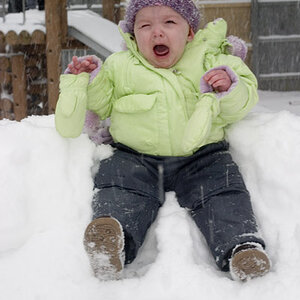
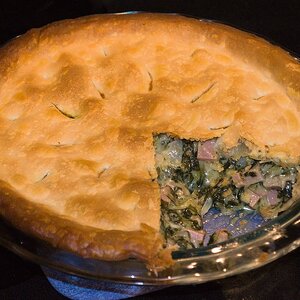
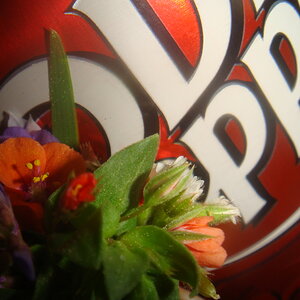
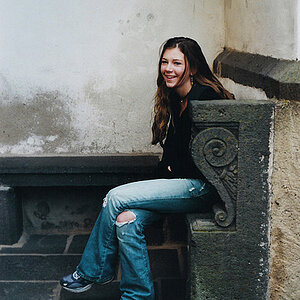
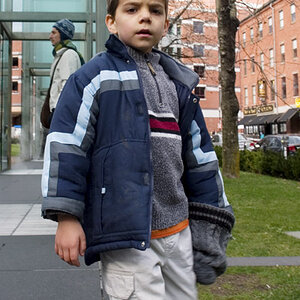
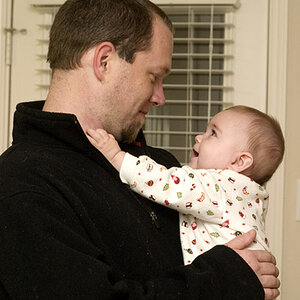
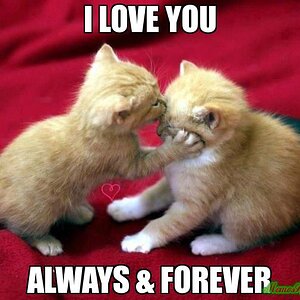
![[No title]](/data/xfmg/thumbnail/33/33421-38d09827e584b8381c5e3a468cdf0159.jpg?1619735961)
![[No title]](/data/xfmg/thumbnail/32/32929-22e23acc63d6ecb25e5ee941be87121f.jpg?1619735758)
